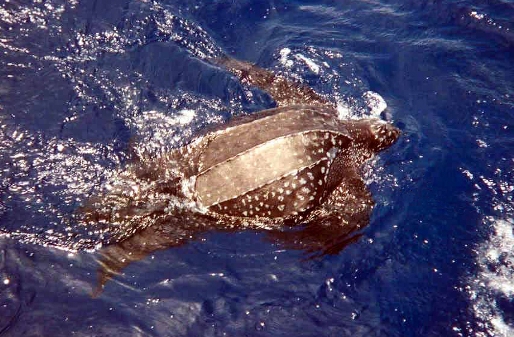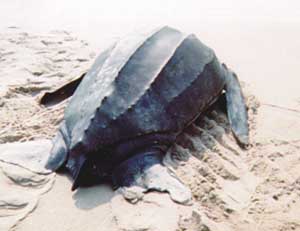Leatherback Sea Turtle

Common Name: Leatherback Sea Turtle
Scientific Name: Dermochelys coriacea
Description
The leatherback is the largest turtle and the largest living reptile in the world. Mature males and females can be as long as six and a half feet (2 m) and weigh almost 2000 lbs. (900 kg). The leatherback is the only sea turtle that lacks a hard, bony shell. A leatherback's carapace is approximately 1.5 inches (4 cm) thick and consists of leathery, oil saturated connective tissue overlaying loosely interlocking dermal bones. The carapace has seven longitudinal ridges and tapers to a blunt point. Adult leatherbacks are primarily black with a pinkish white mottled ventral surface and pale white and pink spotting on the top of the head. The front flippers lack claws and scales and are proportionally longer than in other sea turtles; back flippers are paddle-shaped. The ridged carapace and large flippers are characteristics that make the leatherback uniquely equipped for long distance foraging migrations.
Female leatherbacks lay clutches of approximately 100 eggs on sandy, tropical beaches. Females nest several times during a nesting season, typically at 8-12 day intervals. After 60-65 days, leatherback hatchlings with white striping along the ridges of their backs and on the margins of the flippers emerge from the nest. Leatherback hatchlings are approximately 50-77 cm (2-3 inches) in length, with fore flippers as long as their bodies, and weigh approximately 40-50 grams (1.4-1.8 ounces).
Leatherbacks lack the crushing chewing plates characteristic of sea turtles that feed on hard-bodied prey (Pritchard 1971). Instead, they have pointed tooth-like cusps and sharp edged jaws that are perfectly adapted for a diet of soft-bodied pelagic (open ocean) prey, such as jellyfish and salps. A leatherback's mouth and throat also have backward-pointing spines that help retain such gelatinous prey.
Diet
Jellyfish are the main staple of its diet, but it is also known to feed on sea urchins, squid, crustaceans, tunicates, fish, blue-green algae, and floating seaweed.
Habitat
Leatherbacks are commonly known as pelagic animals, but also forage in coastal waters. In fact, leatherbacks are the most migratory and wide ranging of sea turtle species. Thermoregulatory adaptations such as a counter-current heat exchange system, high oil content, and large body size allow them to maintain a core body temperature higher than that of the surrounding water, thereby allowing them to tolerate colder water temperatures. Nesting female leatherbacks tagged in French Guiana have been found along the east coast of North America as far north as Newfoundland. Atlantic Canada supports one of the largest seasonal foraging populations of leatherbacks in the Atlantic. Leatherbacks tagged with satellite transmitters at sea off Nova Scotia were tracked to waters adjacent to nesting beaches along the northeast coast of South American, the Antilles, Panama and Costa Rica (James et al., 2005).
Leatherbacks mate in the waters adjacent to nesting beaches and along migratory corridors. After nesting, female leatherbacks migrate from tropical waters to more temperate latitudes, which support high densities of jellyfish prey in the summer.
Critical Habitat
U.S. Virgin Islands - A strip of land 0.2 miles wide (from mean high tide inland) at Sandy Point Beach on the western end of the island of St. Croix beginning at the southwest cape to the south and running 1.2 miles northwest and then northeast along the western and northern shoreline, and from the southwest cape 0.7 miles east along the southern shoreline.
Distribution

Leatherback turtle nesting grounds are located around the world, with the largest remaining nesting assemblages found on the coasts of northern South America and west Africa. The U.S. Caribbean, primarily Puerto Rico and the U.S. Virgin Islands, and southeast Florida support minor nesting colonies, but represent the most significant nesting activity within the United States. Adult leatherbacks are capable of tolerating a wide range of water temperatures, and have been sighted along the entire continental coast of the United States as far north as the Gulf of Maine and south to Puerto Rico, the U.S. Virgin Islands, and into the Gulf of Mexico.
The distribution and developmental habitats of juvenile leatherbacks are poorly understood. In an analysis of available sightings (Eckert 2002), researchers found that leatherback turtles smaller than 100 cm carapace length were only sighted in waters 26C or warmer, while adults were found in waters as cold as 0 to 15C off Newfoundland (Goff and Lean 1988).
Reproduction and Development
In the United States, nesting occurs from about March to July. Female leatherbacks nest an average of 5 to 7 times within a nesting season, with an observed maximum of 11 nests. The average internesting interval is about 9 to 10 days. The nests are constructed at night in clutches of about 70 to 80 yolked eggs. The white spherical eggs are approximately 2 inches in diameter. Typically incubation takes from 55 to 75 days, and emergence of the hatchlings occurs at night. Most leatherbacks remigrate to their nesting beaches at 2 to 3-year intervals. Leatherbacks are believed to reach sexual maturity in 6 to 10 years.
Population Trends
The Pacific Ocean leatherback population is generally smaller in size than that in the Atlantic Ocean. Because adult female leatherbacks frequently nest on different beaches, nesting population estimates and trends are especially difficult to monitor. In the Pacific, the World Conservation Union (IUCN) notes that most leatherback nesting populations have declined more than 80%. In other areas of the leatherback's range, observed declines in nesting populations are not as severe, and some population trends are increasing or stable. In the Atlantic, available information indicates that the largest leatherback nesting population occurs in French Guyana, but the trends are unclear. Some Caribbean nesting populations appear to be increasing, but these populations are very small when compared to those that nested in the Pacific less than 10 years ago. Nesting trends on U.S. beaches have been increasing in recent years.
Threats
Leatherback turtles face threats on both nesting beaches and in the marine environment. The greatest causes of decline and the continuing primary threats to leatherbacks worldwide are long-term harvest and incidental capture in fishing gear. Harvest of eggs and adults occurs on nesting beaches while juveniles and adults are harvested on feeding grounds. Incidental capture primarily occurs in gillnets, but also in trawls, traps and pots, longlines, and dredges. Together these threats are serious ongoing sources of mortality that adversely affect the species' recovery. For more information, please visit our threats to marine turtles page.
Conservation Efforts
Because leatherbacks are highly pelagic animals and make long migrations, they come into contact with people of many nations. Therefore, conservation efforts for leatherback populations in one country may be jeopardized by activities in another. Protecting leatherback turtles on U.S. nesting beaches and in U.S. waters alone, therefore, is not sufficient to ensure the continued existence of the species.
Leatherback turtles are protected by various international treaties and agreements as well as national laws. Convention on International Trade in Endangered Species of Wild Flora and Fauna (CITES), which means that international trade of this species is prohibited. Convention on Migratory Species (CMS This link is an external site.) and are protected under the following auspices of CMS: the Memorandum of Understanding on the Conservation and Management of Marine Turtles and their Habitats of the Indian Ocean and South-East Asia (IOSEA) and the Memorandum of Understanding Concerning Conservation Measures for Marine Turtles of the Atlantic Coast of Africa. Leatherbacks are protected under Annex II of the Specially Protected Areas and Wildlife (SPAW This link is an external site.) Protocol of the Cartagena Convention. The U.S. is a party of the Inter-American Convention for the Protection and Conservation of Sea Turtles (IAC This link is an external site.), which is the only international treaty dedicated exclusively to marine turtles.
 Deep Sea Crabs
Deep Sea Crabs